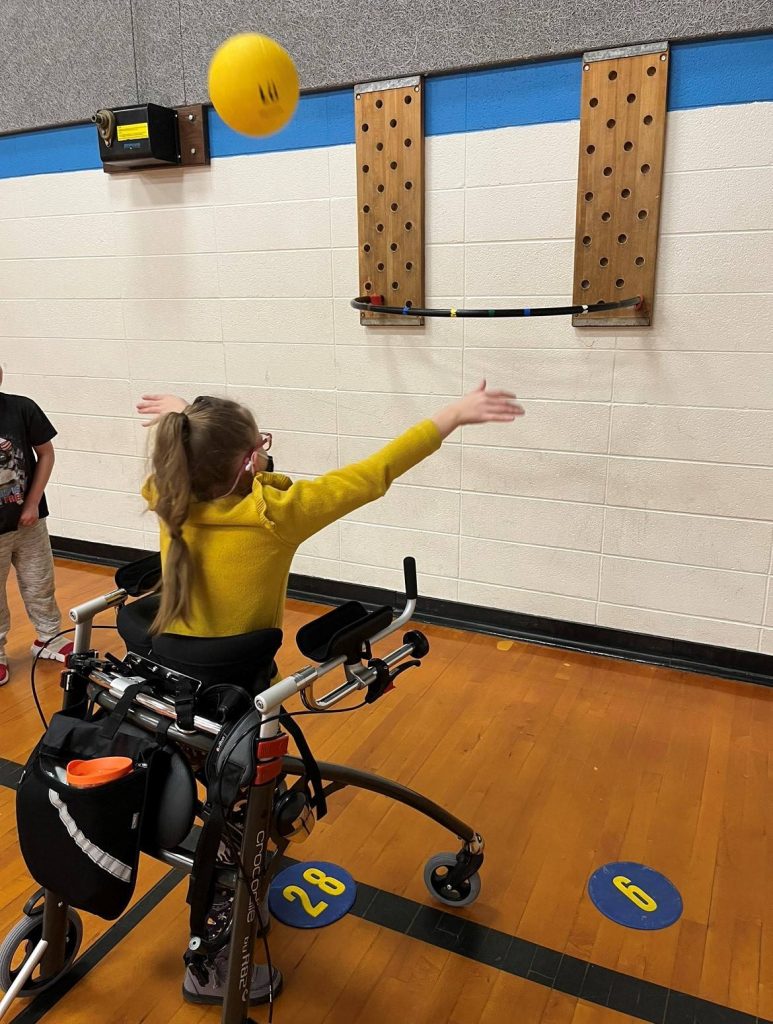-
Mayo Clinic discovery leads to life-changing treatment for young girl with ultra-rare disease

Just months after young Maggie Carmichael started taking an experimental drug for her ultra-rare genetic disease, she was able to trade in her wheelchair for a walker. The 9-year-old Mayo Clinic patient even took a few of her first-ever steps on her own. She also became better at feeding herself, her speech improved and she started coloring in the lines.
"It's almost like we finally got to meet Maggie," says her mother, Holly Carmichael. "It was all in there this whole time. She is so funny, and she has such an amazing spirit, and I can't even describe to you because it feels unreal to me that we're in this spot."
Maggie was born with a tiny glitch in her DNA that has led to monumental health issues — from developmental delays and severe motor deficiencies to muscle weakness and retinal degeneration.
"Her aorta is actually wrapped around her esophagus, and she has some liver issues," says Holly, who has been on a tireless quest to find a treatment for her daughter.
Now, after years of searching, the Carmichaels are hanging their hopes on an investigational new drug that seems to be helping with some of Maggie's symptoms.
Maggie's ultra-rare genetic disease
Maggie's disease is part of a category of diseases known as congenital disorders of glycosylation. The group of 170 diseases affects the body's ability to attach sugar chains to proteins, which is essential for the function of tissues and organs. Each step in the sugar chain construction process is initiated by an enzyme — a type of protein that speeds up chemical reactions. People with congenital disorders of glycosylation lack one of these enzymes and experience widespread complications.
Maggie's specific enzyme mutation affects fewer than 1,000 people worldwide. The mortality rate in early childhood is 20%.
Mayo Clinic physician blazing a trail of scientific discoveries

Maggie’s treating physician is Eva Morava-Kozicz, M.D. Ph.D., a translational scientist at Mayo Clinic who is at the forefront of research on congenital disorders of glycosylation. Dr. Morava-Kozicz has treated patients for more than 20 years. She oversees one of the world's largest biobanks and has a lab dedicated to advancing discoveries, diagnostics and therapies for the complex disease. Dr. Morava-Kozicz also leads an international team of experts researching these disorders as a part of the NIH-funded Rare Diseases Clinical Research Network.
In a recent discovery, Dr. Morava-Kozicz and her collaborators found that one of the major culprits of congenital disorders of glycosylation is a buildup of a substance called sorbitol, which is a type of sugar alcohol that is produced in the body when glucose is metabolized.

Dr. Morava-Kozicz says the sorbitol discovery opened the door to a diagnostic biomarker for the disease and for tracking disease severity. She says the biomarker advancement provided a strategy for implementing potential drug candidates.
"And then we were able to test specific drug candidates on different patient cell lines in the biobank," Dr. Morava-Kozicz explains. "Maggie's cell line was one of the cell lines that really reacted with a positive response."
She says the drug shows potential in increasing enzyme activity, though she emphasizes it is not a cure.
"If the enzyme works better, the sugar chains will exponentially improve," Dr. Morava-Kozicz explains. "When proteins are decorated with sugar chains they work much better."
Dr. Morava-Kozicz's hope and expectation is that Maggie's experience will help pave a way for treatments for more patients.
Ultimately, she envisions a day when errors in cells can be corrected to potentially provide cures for her young patients. She and her colleagues in Mayo Clinic's Center for Individualized Medicine are currently investigating a therapy called "antisense oligonucleotides." The pieces of custom-made DNA or RNA can turn off mutated genes or enhance gene function so all the cells can function better.
"We are at the level of trying the antisense oligonucleotides in patient cells in the same way we did with the drug candidates," she says.
For now, Dr. Morava-Kozicz says she's grateful to see Maggie thriving.
"Maggie is a bit of sunshine. She's genuine, kind, warm and cheerful – just like the other children I care for," Dr. Morava-Kozicz says. "You have to meet these kids because they seem to have a genetic benefit of being wonderful."
Mayo Clinic has a financial interest in the therapeutic referenced in this story.








